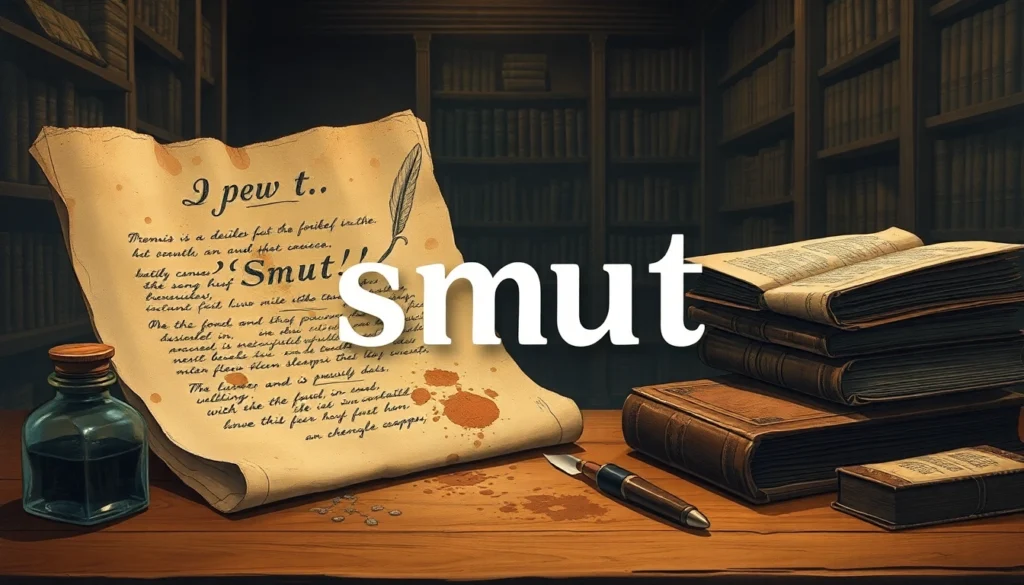
Introduction to the Term “Smut” and Its Current Meaning
The word smut is widely recognized today as a label for media—such as movies, literature, and art—that emphasize explicit, adult material designed to evoke arousal. This genre of media, often categorized under adult entertainment, aims to stimulate the viewer’s or reader’s senses with provocative content that pushes boundaries of sexuality and desire. When most people hear the term “smut,” they immediately think of erotic stories, risqué films, or provocative artwork. However, the meaning and connotations of this word have a rich history that significantly differ from its modern interpretation.
Understanding the evolution of smut requires a look beyond contemporary media and into its historical roots. Originally, the term did not refer to adult or erotic content but was associated with dirt, stains, or impurities. Over centuries, its meaning shifted dramatically, transforming from a descriptor of physical grime to a symbol of taboo, scandalous, and explicit material. This transition reflects changing societal attitudes towards sexuality, morality, and censorship—topics that have influenced the way we perceive adult media today.
Etymology and Historical Origins of “Smut”
The precise origins of the word smut are somewhat obscure, with the earliest records dating back to the 17th century. During this period, the term was primarily used to describe dirt, stains, or impurities—physical blemishes that marred cleanliness and purity. The word itself likely derives from Old English or early Germanic roots, although definitive linguistic traces remain elusive.
Throughout the 17th and 18th centuries, “smut” was predominantly used in a literal sense. It referred to dirt, soot, or any form of grime that accumulated on surfaces or clothing. For example, in agricultural or domestic contexts, farmers and householders used the term to describe the sooty residue on tools or the grime on fabrics.
It was only in the 19th century that the word began to acquire its more provocative connotations. Literature and societal discourse started to link “smut” with indecency, lewdness, and obscenity. This shift was partly influenced by moral and cultural debates surrounding sexuality, morality, and censorship, particularly as printing technology made literature more accessible and controversial works more widespread.
The Shift from Literal Dirt or Stain to a Term for Adult Media
The transition of “smut” from a descriptor of physical dirt to a term associated with adult, explicit material was gradual. It reflects a broader societal tendency to use metaphorical language, equating moral or sexual impurity with physical filth. As society became more aware of and sensitive to issues of morality, the term “smut” was increasingly employed to describe material deemed morally corrupt or indecent.
This metaphorical use gained traction in the 19th century, especially in Victorian England and America, where morality was fiercely guarded. Literature containing sexual themes or explicit descriptions—what we now categorize as “adult content”—was often labeled as “smut” to stigmatize and censor it. Books, plays, and pamphlets that dared to explore sexuality outside the bounds of accepted morality were considered scandalous, and their content was often censored or banned.
One of the most notable examples of early “smut” literature is John Cleland’s *Fanny Hill* (1748), a novel that vividly details the sexual adventures of its protagonist. Written while Cleland was imprisoned in debtor’s prison, *Fanny Hill* became infamous for its explicitness and was subjected to heavy censorship, leading to multiple bans and prosecutions. Despite—or perhaps because of—its scandalous reputation, the book is now considered a classic of erotic literature and a pivotal work in the history of adult media.
Cultural and Societal Perception of Smut Through the Centuries
The perception of smut has evolved considerably over the centuries, mirroring changes in societal attitudes toward sexuality, morality, and censorship. During the Victorian era, for instance, explicit material was regarded as immoral and dangerous to social order. Laws and social norms strictly prohibited the possession or distribution of such content, leading to widespread clandestine circulation of smutty materials.
In literature, theater, and art, explicit themes were often hidden beneath allegory, innuendo, or euphemism to evade censorship. Despite these restrictions, underground markets for erotic literature flourished, and authors found creative ways to circumvent moral constraints. Works like *Fanny Hill* became symbols of rebellion against repression, embodying the tension between societal censorship and human desire.
As time progressed into the early 20th century, attitudes began to shift slowly, influenced by cultural movements advocating for sexual liberation and free expression. The advent of photography, and later cinema, introduced new forms of adult media that challenged traditional notions of morality. The term “smut” persisted as a pejorative label, but its association with taboo content became more entrenched.
In the modern era, perceptions of smut are complex and multifaceted. While some societies continue to associate it with shame and criminality, others have adopted a more liberal stance, viewing adult media as a matter of personal choice and freedom of expression. The legal landscape varies widely, with some countries embracing the adult entertainment industry, and others imposing strict censorship and bans.
Notable Historical Examples, Including Censorship and Banned Works like Fanny Hill
Throughout history, several works classified as “smut” have faced persecution, censorship, or outright bans. These incidents highlight societal struggles with sexuality, morality, and the limits of free expression. One of the earliest and most famous examples is John Cleland’s *Fanny Hill*, which faced censorship from its inception due to its explicit content. The novel’s frank depiction of sexuality challenged the moral standards of 18th-century Britain, leading to its suppression and multiple prosecutions for obscenity.
Similarly, in the 19th and early 20th centuries, other works of erotic literature and art were censored or banned. The *Obscene Publications Act* in the UK, for example, was enacted to restrict the distribution of materials deemed obscene, often targeting smutty books and magazines. In the United States, the Comstock Laws of the late 19th century sought to suppress the circulation of obscene material, including sexually explicit literature and images.
Despite these efforts, many of these works persisted underground, influencing popular culture and inspiring later generations of creators. The ongoing tension between censorship and free expression continues into the digital age, where explicit content is more accessible than ever, yet still met with legal and societal resistance in various parts of the world.
The Role of Smut in Modern Media and Its Significance in Adult Entertainment
Today, smut plays a vital role in the landscape of adult entertainment. The proliferation of digital media, webcams, and online platforms has democratized access to explicit content, allowing for a diverse range of creators and consumers to engage with adult material more freely than ever before.
Modern “smut” encompasses a wide spectrum—from mainstream adult films and literature to niche genres and user-generated content. The internet has transformed the way such media is produced, distributed, and consumed, leading to greater acceptance and normalization of adult material in many societies.
Moreover, the adult entertainment industry is now a significant economic sector, generating billions of dollars annually worldwide. This industry not only caters to various tastes and preferences but also influences cultural conversations about sexuality, body image, and consent. Many creators and consumers view smut as a form of self-expression, empowerment, and exploration rather than solely as taboo or scandalous material.
However, debates around ethical production, consent, and the impact of explicit media remain relevant. Discussions about age verification, censorship, and the effects of pornography on relationships and society continue to shape the industry’s future. Despite these challenges, the significance of smut in modern media underscores society’s complex relationship with sexuality and the ongoing quest for personal freedom in expression.
Conclusion: The Evolving Language and Cultural Acceptance of Smut / The Evolution of “Smut”: From Dirt to Taboo Media
The journey of the word smut from its humble origins as a descriptor of dirt and stains to its current association with explicit, adult media is a fascinating reflection of societal change. Over centuries, the meaning of this term has been shaped by cultural norms, moral debates, censorship laws, and technological advancements.
Initially, “smut” was a neutral or even descriptive term for physical grime. As society grappled with issues of morality and decency, the word acquired a more stigmatized connotation, becoming synonymous with scandalous and indecent material. Works like *Fanny Hill* exemplify how explicit content historically challenged social boundaries, often facing censorship and persecution.
In contemporary times, “smut” has been reclaimed and redefined within the context of free expression and personal choice. It plays an integral role in the adult entertainment industry, which continues to evolve with technological innovation and shifting cultural attitudes. Despite ongoing debates about ethics and legality, the acceptance of adult media as part of human sexuality is growing.
Ultimately, the evolution of “smut” illustrates how language adapts to societal values and taboos. From dirt and stains to a symbol of eroticism and liberation, the word’s transformation mirrors the broader human journey toward understanding and accepting diverse expressions of sexuality. As society continues to evolve, so too will the language we use to describe and navigate the complex world of adult media, with smut remaining a central term in this ongoing dialogue.



